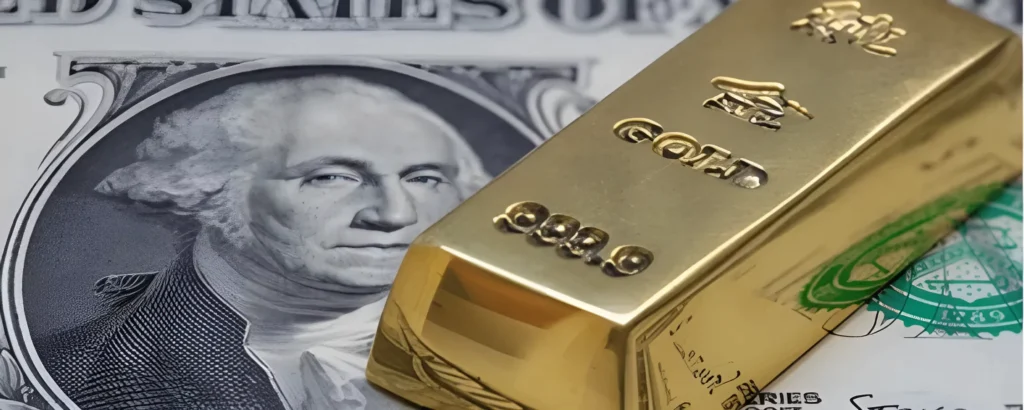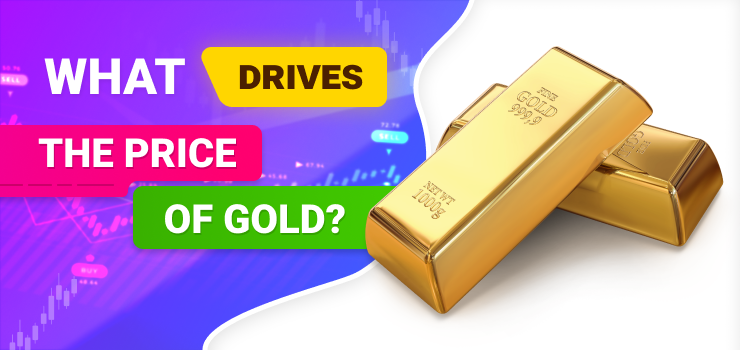As an alternative asset and inflation hedge, gold plays an important role in balanced investment portfolios. However, its price movements do not always correlate neatly with broader economic indicators. Determining what drives the price of gold requires understanding various macroeconomic and geopolitical factors influencing demand. This article examines gold’s key price triggers including currency rates, inflation expectations, interest rates, investor sentiment, and more. Grasping gold’s valuation drivers equips investors to optimally deploy it within diverse portfolios.
Does the US Dollar Impact Gold Prices?

The US dollar significantly impacts gold prices as it is considered the primary counterpart to the dollar. When the dollar strengthens, gold often declines as international buyers find it more expensive while dollars buy relatively more gold. Weakness stimulates buying as foreign reserve managers and investors seek an alternative reserve asset. Economic strength also lifts the dollar potentially pressuring bullion. Charts often evidence the inverse gold-dollar relationship strengthening during risk-off periods.
Currency valuation dynamics crucially determine what drives the price of gold in the short to medium term. A stronger dollar increases gold costs to buyers abroad stimulating selling pressures. Increased dollar liquidity enters markets through quantitative easing diluting all other currencies against it. This phenomenon pressured bullion values considerably post-2008 crisis as the Fed injected trillions. Rising real US yields motivate dollar favoritism versus gold and other currencies over time as well.
Conversely, dollar bears stimulate safe-haven gold demand. When global or domestic economic concerns emerge sparking dollar liquidations, gold often rallies as market participants diversify reserves. Post-1987 market crash, 1998 LTCM crisis, and 2001 recession, gold outperformed other assets as geopolitical and financial uncertainty spiked. Emerging market central banks especially boost holdings amid devaluing reserves maintaining purchasing power. Dollar weakness therefore positively correlates to bullion values by affecting its competitive pricing globally.
How dollar strength/weakness impacts gold demand
As both stores vastly differing quantities of value, the dollar and gold exhibit an almost perfectly inverse short and medium-term correlation. Periods of dollar strength tend to coincide with gold weakness and vice versa. Their relationship centers on opportunity costs and wealth preservation qualities driving demand shifts between the dollar and gold. Understanding deviations informs anticipating turning points supporting one over the other. For example, geopolitical risks may temporarily decouple gold from dollar performance during crises increasing safe-haven flows.
How Interest Rates Affect Gold Prices

Interest rates also significantly influence “what drives the price of gold” especially US real rates. Higher real rates tend to correlate negatively with gold as they increase the opportunity cost of holding non-yielding bullion. When inflation-adjusted bond yields rise, gold investing becomes less comparatively attractive on a risk-adjusted basis. This relationship held throughout much of the 1980s as then Fed Chairman Paul Volcker aggressively hiked rates quashing double-digit inflation.
However, the correlation varies based on economic circumstances. Gold historically rises when inflation expectations outweigh rate hikes as rising costs devalue paper currencies over time. Negative real rates motivate gold investment as an inflation offset. Periods like the late 1970s inflationary crisis amplified this dynamic boosting bullion values enormously against eroding currencies despite rising nominal rates. Rate cycles therefore exhibit short-term headwinds countered by supportive long-term relationships as gold constitutes a store of value offsetting currency erosion when priced in constant dollars.
Gold’s performance during periods of rising/falling rates
Understanding deviations inform optimum gold investment. For example, inflation threatening to accelerate faster than rate hikes sparks safe-haven gold inflows. Gold outperformed bonds considerably during the late 1970s as this scenario played out. In contrast, disinflation allows bonds to yield more than gold in real terms, pressuring it. Demand therefore centers on inflation adjustments to interest rates driving real returns. Sustained high nominal and real rates favor bonds, potentially pressuring bullion unless inflation expectations rise considerably ahead of them.
The Link Between Inflation and Gold Prices

Inflation expectations represent another crucial driver of “what drives the price of gold”. As a traditional hedge against currency debasement, gold historically rises as consumers lose faith in currencies and asset values during periods of escalating prices. Central bankers commonly respond to rising inflation by loosening monetary policy stimulating further price increases in a vicious cycle. This risk motivates portfolio diversification into the yellow metal as its supply remains relatively stable.
Inflation served as the primary investment thesis driving gold’s parabolic price surge throughout the 1970s as monetary authorities struggled to curb rising costs. Prices jumped from $35/ounce in 1970 to over $800/ounce in 1980 – a gain of over 2000% in constant dollars. Geopolitical factors also played into inflationary pressures at the time through the 1973 oil crisis. Nevertheless, losing purchasing power represented the chief motivation for rotating out of paper holdings.
The role of energy prices in inflation pressures
Energy costs play a linked role as their spikes indirectly signal general price pressures across economies. Oil represents a key industrial commodity factoring into production expenses across supply chains. Surging energy prices during the 1970s thus compounded underlying inflation concerns driving “what drives the price of gold”.
More recently, recession-induced quantitative easing revived inflation fears stimulating bullish flows during the 2009-2011 recovery. Gold climbed over 60% from 2008 lows on speculation central bank debt monetization could spark sustained price increases down the line. While low inflation persisted, gold investment reflected apprehension. Understanding inflation dynamics informs gold’s role as a defensive portfolio diversifier against currency debasement.
The Impact of Geopolitical Risk on Gold

Geopolitical risk factors prominently into short and medium-term dynamics. Unpredictable events like terrorist attacks, regional conflicts, and trade disputes inject uncertainty motivating safe-haven diversification. Gold investment frequently spikes during periods of heightened volatility as market participants seek a stable currency-independent store of value. Bullion often represents the premier asset class benefitting from these “flight-to-safety” rotations.
Post-9/11 terror attacks exemplified geopolitics’ stimulative impact. Gold jumped over 20% in the subsequent months as investors fled equities for safe assets. Tensions like the Gulf War during the early 1990s provided another example of lifting gold over 30% within a year on risk aversion. Closer to the present, risk events like Brexit also fueled gold inflows in 2016 alleviating short-term dollar strength headwinds.
Domestic political instability within major economic powers may similarly boost gold prices. Controversial leadership changes introduce uncertainty motivating diversification. Bullion represented a primary beneficiary of the eurozone sovereign debt crisis threatening the currency bloc during 2011-2012 for example. Contagion risks surrounding large economies’ fiscal troubles supported monetary demand as a neutral alternative.
The Role of Investor Sentiment
Understanding correlations between gold and broad market volatility informs optimum timing. During periods of low VIX index readings indicating complacency, gold typically underperforms versus riskier assets. However, geared exposure complements portfolio diversification objectives by capitalizing on risk-off flows. Overall, gold benefits from an uncorrelated safe-haven profile appreciated during turbulence across currencies and asset classes.
Conclusion
Overall, it is necessary to take into account a range of interconnected macroeconomic, political, and market-based factors in order to figure out what drives the price of gold. The value of the US dollar overseas, current nominal and real interest rate environments, inflation expectations, energy costs, geopolitical risks, stability of global growth, and short-term investor sentiment are all factors that affect gold prices, as this article has explored.
Although there isn’t a single factor that determines the direction of gold all the time, understanding these variables and how they affect the metal differently offers important insight into both the safe-haven responsibilities that gold plays and potential pressures that could occasionally work against bullion returns. Through comprehension of past correlations and the possibility of decoupling, investors can strategically utilize gold as a crucial portfolio diversifier that yields profits throughout market cycles.



